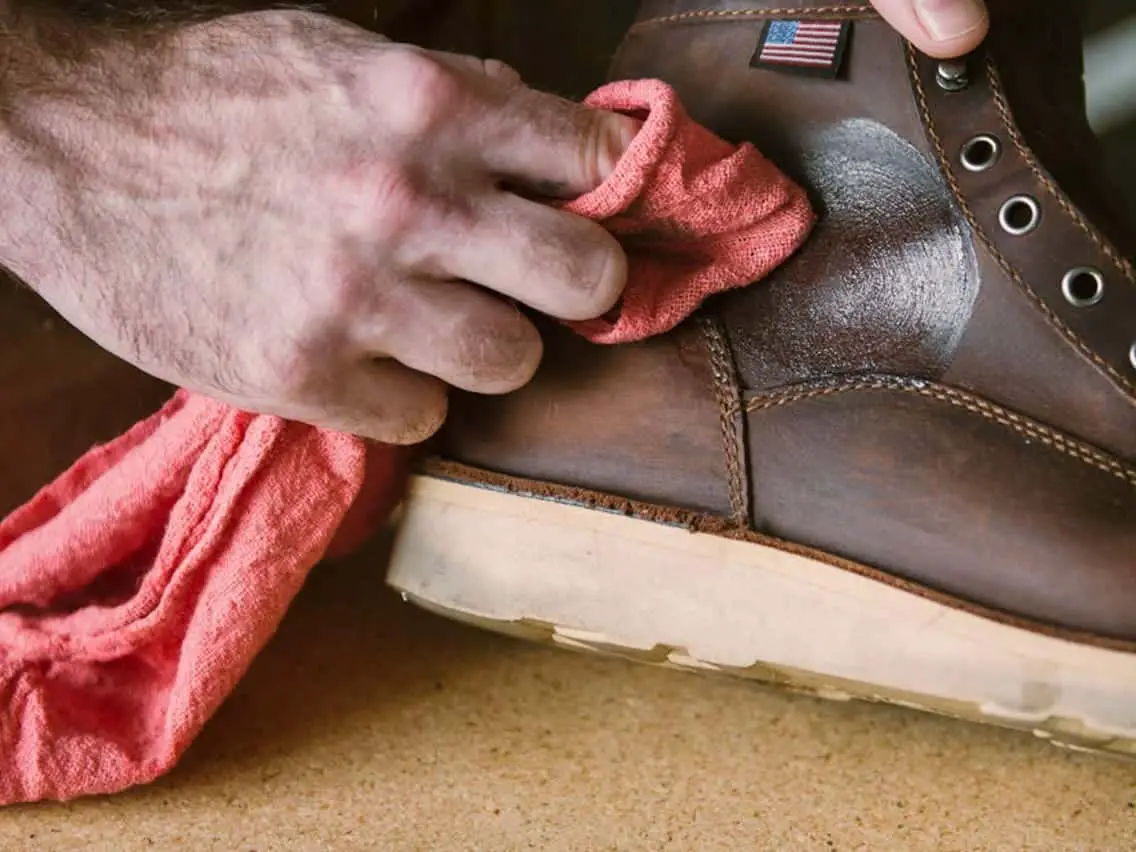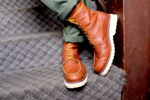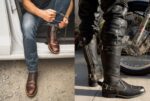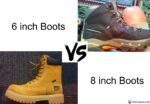Summer or winter, rain really never leaves us completely!
May be it’s the summer rain, or the true monsoon, or the downy flakes of the snowy winter, water never spares a chance to trouble us.
And if it’s the fall season, you should know it’s time to prepare your boots to face the moisture and to get them the waterproofing done!
Although our body can cope up with the water easily, it’s not the same with the boots!
Be it leather or suede or rubber, boots get damaged with constant exposure to water. And the only thing that can save the boots from the deadly hands of water is a good waterproofing!
And thank God there are some great ways of waterproofing your boots and I have solution for every boot; be it leather or Nubuck or suede or the fabric ones.
Boots can be made waterproof using 3 methods: using wax sealants, using silicone sprays and using cream sealants. Silicone sprays and the cream sealants are the newest in the line of waterproofing and are easy to apply, but wax has got its own base and holds on to the boots for longer than the rest two.

In this article, I am going to explain you all the processes for waterproofing each types of boots in detail along with the best products for them.
So, why wait?
Let’s get scrolling guys!
Best waterproofing products for different types of boots
| Type of boots | Waterproofing products |
| Best wax for leather boots | Obenauf’s Heavy Duty LP Leather Conditioner Natural Oil |
| Best silicone spray for leather boots | Atsko Silicone Water-Guard |
| Best waterproofing agent for nubuck and suede boots | Nikwax Nubuck and Suede Proof Waterproofing |
| Best spray for fabric boots | KIWI Sneaker and Shoe Waterproofer |
| Best spray for hiking boots | KIWI Boot Waterproofer |
Waterproofing Leather Boots by Using Wax
Being animal skin, leather has got waterproof feature in itself to some extent. But over time due to drying or overuse cracks are formed and the natural moisture is lost and leather loses its water repelling capacity.
Waxing is one of the easiest and the best known methods to make leather boots waterproof. But there are certainly a specific way to do the task because just applying the wax and thinking you are done is definitely not going to work.
The following steps will tell you how to get the job done correctly:
1.) First of all clean the boots thoroughly with the help of a horsehair brush. This will get away with all the loose dirt from the boots.
2.) Next, take a damp lint free cloth and rub in circular motions to take off the settled dust and grim from the boots.
3.) If your boots are still not clean, dip the lint free cloth in the soap-water solution and again rub in gentle circular motions.
4.) Use a hairdryer to dry the boots and also to heat the boots up.
5.) Take a small amount of wax in a cloth and rub over the leather gently. Apply the hairdryer once again to soften the wax if necessary.
6.) Repeat the process until the entire boot is coated in the wax.
7.) Work in layers (at least 3 to 4 layers) to build up the wax on the boots.
8.) Leave it for at least 1 hour and allow the wax to dry naturally on the boots.
9.) Do not touch the boots in between or else the wax might crack.
10.) After 1 hour, take your boots and gently buff the wax, so that the boots look smooth all around.
11.) The next step is to condition your boots so that the waterproofing lasts longer.
12.) In order to condition the boots, take a small amount of conditioner on your fingers or on a soft lint free cloth and apply in circular motions.
13.) Repeat the process until the entire boot is covered with the conditioner.
14.) Conditioning the boots will not only retain the waterproofing properties, but will also replenish the leather fibers, bring back the nutrients and moisture to the leather and will make them look supply and shiny.
15.) That’s all you are done guys! Just leave the boots overnight under the fan and let them dry naturally!
You can use the wax recommended below:
- Leather conditioner cream with real beeswax and plant oils designed to melt when spread on by hand
- Heavy Duty LP waterproofs and resists acids, petroleum, salt, and chemicals on leather work boots
- Condition, restore dried and sun faded leather furniture and leather auto interiors
- Complete leather care proven to resist scuffing, stitch tear, and cracking
- Heavy Duty Leather Preservative is Made in the USA
Prices pulled from the Amazon Product Advertising API on:
Product prices and availability are accurate as of the date/time indicated and are subject to change. Any price and availability information displayed on [relevant Amazon Site(s), as applicable] at the time of purchase will apply to the purchase of this product.
Waterproofing Leather Boots using Silicone Spray
Silicone sprays are easier to work with as compared to the wax:
1.) First of all clean the boots nicely using a clean cloth and then a damp cloth.
2.) Then spray the silicone spray all over the boots evenly.
3.) You can re-spray if needed.
4.) Let the boots dry and you are done!
- KIWI Boot Waterproofer provides tough silicone protection for work and outdoor boots
- Waterproof spray for boots
- Spray has unique formula that bonds to leather and fabrics
- Creates an extremely tough water barrier, while still allowing materials to breathe
- Protect your pride, whatever the weather
Prices pulled from the Amazon Product Advertising API on:
Product prices and availability are accurate as of the date/time indicated and are subject to change. Any price and availability information displayed on [relevant Amazon Site(s), as applicable] at the time of purchase will apply to the purchase of this product.
Waterproofing Welt-seam of the Boots
It’s very important to waterproof the seam as well or else water might enter the boots through the welt-seam. This is to be done after cleaning the boots and before applying the waterproof coating to the boots.
1.) Clean the boots off loose dirt.
2.) Use a clean soft lint free damp cloth to clean if necessary.
3.) Allow the boots to dry under the fan.
4.) Apply the urethane sealant by running a thin bead around the welt-seam.
5.) Allow it to dry for 1 hour.
6.) You can then start with waterproofing the rest of the boots.
Waterproofing Nubuck leather and Suede boots
Nubuck leather or suede is very different from normal leather. They are furrier and more delicate than original leather. So, never apply solid wax on these boots. Solid wax can destroy the furs on these boots and completely damage them. Instead go with wax sprays for these boots.
1.) The very step is always to clean the boots thoroughly.
2.) In this case, use a soft bristled toothbrush or horsehair brush to brush off the loose dirt.
3.) Once the boots are clean, you can take the waterproofing spray and spray on the boots from a distance of at least 5 cm so that the spray spreads over a certain area.
4.) Spray over the entire boot evenly and leave to dry for 1 hour.
5.) You can apply a second coating if needed.
6.) Now take a soft horsehair brush and buff the leather fibers gently. This ill bring back the shine to the boots.
This is one of the perfect products for getting the job done:
- Adds water Repellency to synthetic or leather footwear while preserving texture
- Clean first with Nikwax footwear cleaning gel for best results
- Manual or spray-on application
- Recommend for use on all textured leather shoes, coats, and gloves; safe for GORE-TEX
- Water based, biodegradable, and contains no PFCs, VOCs, optical brighteners, or added scent
- Sport Type: Camping & Hiking
Prices pulled from the Amazon Product Advertising API on:
Product prices and availability are accurate as of the date/time indicated and are subject to change. Any price and availability information displayed on [relevant Amazon Site(s), as applicable] at the time of purchase will apply to the purchase of this product.
Waterproofing Fabric Boots
Fabric boots are hard to make waterproof because fabric (basically a cloth material) will definitely soak in water sooner or later.
But still, there is a little effort you can put on them to give it a try:
1.) For cleaning the fabric boots, you will need soap water solution and a toothbrush.
2.) Dip the bristles of the toothbrush in the soap-water solution and brush on the boot fabric in gentle circular motions.
3.) Now take a clean damp cloth and rub off the soap-water residue from the boot fabric.
4.) Once the boots are clean, dry them using the hairdryer or naturally under the fan.
5.) When the boots are dry, apply the waterproof spray all over the boots.
6.) Apply another coating if necessary and voila you are done after drying the boots!
You can use KIWI Sneaker and Shoe Waterproofer for your fabric boots and shoes:
- KIWI Sneaker Protector is a powerful waterproof spray for shoes that guards against rain, stains, salt and dirt
- Waterproof spray and stain repellent create an invisible shield for your shoes while allowing them to breathe
- Suitable for Full Grain and Patent Leather, Synthetic and Faux Leather, Canvas, Suede, Nubuck, Mesh, Nylon and Fabric
- Step 2 of the 3 Step KIWI Sneaker Care system
- Helps shoes last longer
Prices pulled from the Amazon Product Advertising API on:
Product prices and availability are accurate as of the date/time indicated and are subject to change. Any price and availability information displayed on [relevant Amazon Site(s), as applicable] at the time of purchase will apply to the purchase of this product.
Waterproofing Hiking Boots
Hiking boots are meant o be for tough weather. Coming in contact with water is the first thing that hiking boots need to prepare for. Therefore, they are already coated with waterproofing treatments for a great performance.
However, over time, the water repellency of the boots fade away and the boots become of no use. This is the time when you need to go for the waterproofing treatment for these boots and this is how the steps should go:
1.) First of all remove the laces from the boots and wash them in soap-water solution to clean them off the dirt.
2.) Now take a soft brush and brush off the loose dirt from the boots.
3.) You can also wash the boots in soap-water solution and then in running water to clean them thoroughly.
4.) Once the boots are clean, start preparing for the waterproofing treatment ASAP because wet boots will soak in the waterproofing agents better than the dry boots.
5.) You can now apply the waterproofing agent on the bots using a soft cloth.
6.) Work in layers with the waterproofing agent to get a better coverage.
7.) Dry the boots under the fan.
8.) Once the boots are dry, do not forget to apply a good boot conditioner to make the waterproofing effect last longer.
9.) Dry the boots completely and they should be good to go once again!
This product works great for hiking boots:
- KIWI Boot Waterproofer provides tough silicone protection for work and outdoor boots
- Waterproof spray for boots
- Spray has unique formula that bonds to leather and fabrics
- Creates an extremely tough water barrier, while still allowing materials to breathe
- Protect your pride, whatever the weather
Prices pulled from the Amazon Product Advertising API on:
Product prices and availability are accurate as of the date/time indicated and are subject to change. Any price and availability information displayed on [relevant Amazon Site(s), as applicable] at the time of purchase will apply to the purchase of this product.
FAQs
When to waterproof boots and shoes?
The answer is in a good weather day! By a good weather day I mean late summer or before the fall, in other words before the weather gets damp with moisture in it before the winter arrives.
Winter is the time when the air has a lot of moisture in it and the effect will be shown on your boots too. So, it’s always better to pre-apply the waterproofing coating on your boots before they get hit by the damp weather.
When to repeat a waterproofing treatment for leather boots?
You should know it’s time to renew the waterproofing treatment for your leather boots once again when you see the layer of finish of the on the boots has broken down and it looks cracked and dull devoid of life. The cracks would indicate chances of seepage of water inside the boots.
In case of wax waterproofing treatment:
If you had earlier treated your boots with wax based waterproofing agents, and the top layer of the boots has scuffed and the leather is looking dry and dirty enough, you should know it’s a sign that the top layer of the wax is gone and it’s time to redo the waxing treatment on your boots once again.
In case of silicone waterproofing treatment:
If you had treated your boots earlier with silicone sprays as a waterproofing coat, you should it’s time to reapply the spray when areas on the boots start to get darker.
Darker areas simply mean that the boots have once again started to absorb moisture and its water repelling capacity has gone down.
Which is better for our boots? Waxing or Silicone Spray?
Actually both should do the job completely fine and depends entirely on you which product you would like to choose. However there are definitely certain differences which are as follows:
1.) Using silicone sprays is time saving. Just clean the boots and apply the spray and it’s done.
2.) Wax treatment is an old school treatment and is time taking. You need to build up layers with your hand, melt the wax in between if needed and again start working if necessary.
3.) The effect of silicone spray waterproofing will last you up to 1 to 2 weeks and then you need to again reapply it.
4.) The effect of wax treatment on the boots will last you the entire season if the coating is done correctly.
When to use wax treatment?
You can use the wax treatment on old boots that are already broken-in because if you apply wax coating to new boots, once they start breaking-in, it will form cracks on the wax layers.
When to use silicone sprays?
You should use the silicone spray to new boots that not still broken-in or the newly re-soled boots so that it doesn’t get wax in the welting.
Will WD40 waterproof boots?
Yes WD40 definitely works a great waterproofing agent for leather boots and shoes. All you need to do is just clean your boots with a rag to get the dirt off and then spray WD40 all over the boots. after that just buff the leather using the horsehair brush.
WD40 acts a barrier to prevent water from penetrating into the leather thus, keeping the boots water-resistant.
Can you use Vaseline to waterproof boots?
Yes, Vaseline will work as a waterproofing agent, but for a very short period of time. As soon as the layer of Vaseline gets rubbed off from the boots, the waterproofing effect also will go away with it.
Does waterproofing spray works?
As mentioned in the sections above, waterproofing spray is the easiest and fastest way to waterproof your boots. Just remember to use the right product for the particular material of your boots.
Should you waterproof waterproof boots?
If you have bought a brand-new pair of waterproof boots, there is absolutely no necessity to waterproof them out of the box.
But you never know when those boots were manufactured and thus when the waterproofing coating was applied to them the last time. It might be 1 year earlier!
So, in that confusion, you can try performing a small test on your new waterproof boots:
-
-
- Take the pair of new waterproof boots
- Sprinkle generous amount of water on it
- See if water forms beads on the surface of the boots and then slips off
-
If the water forms beads on the surface of the boots and then slips off, you can skip waterproofing the boots for another month.
But if the drops of water collected on the surface of the boots get soaked in the boots, leaving behind water stains on the leather surface, you should definitely waterproof your boots immediately.
Is mink oil good for waterproofing boots?
Mink oil is extracted from the fatty layer of mink’s skin and usually has a waxy texture to it. This waxy texture makes way for the waterproofing feature of mink oil.
Yes, mink oil definitely is a good option for waterproofing your leather boots besides softening, conditioning and preserving the leather fibers. But choose the mink oil paste when it comes to just waterproofing the boots. (Should You Mink Oil Boots that are Already Waterproof?)
It’s time to bid Adieu!
Hi workgearz fan!
I hope you enjoyed reading the article!
Remember each time we write an article for you, we intend to make your jobs easier for you!
And hope this article too helped you with knowing facts about waterproofing your work boots!
That’s all for today! Take care; stay safe until we meet in the next article!
Happy boots waterproofing!








